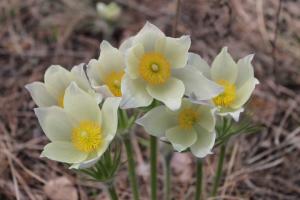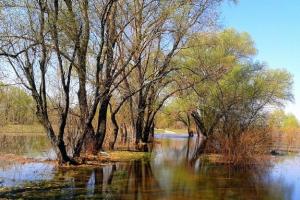Wild berries are much healthier than cultivated berries. Wild berries grow in natural conditions, are not treated with drugs, and do not contain radionuclides or heavy metals. Wild forest berries provide a full range of minerals, vitamins and other beneficial elements. However, in the forest you can find not only berries, but also inedible berries. Let's take a closer look at which berries are inedible and why it is better not to eat such wild berries.
Juniper berries are inedible, and Cossack juniper berries can cause serious poisoning
Juniper is an inedible berry
- Common juniper- evergreen large shrub or small tree up to 3 m high. The trunk is covered with grayish-brown flaky bark. The leaves are needle-shaped, linear-subulate, spiny, widely spaced and collected in whorls of three. Flowers - in the form of a dioecious cone, blooms in June. The fruit is a juicy coneberry, green in color, ovoid in shape in the first year of life, and black-blue, spherical in the second year, with a shiny waxy coating, equipped with a three-ray groove at the top. The size of the cone berry is 7-9 mm. Its pulp contains 2-3 greenish-brown triangular seeds, which ripen in the fall of the second year. Grows in soils with moderate or high humidity, prefers coniferous, especially composite forests, found in clearings, clearings, on the edges and forest clearings.
- Juniper dahurian- a less common species, found in small groups or singly in some areas of the Khabarovsk Territory. Grows on rocky slopes, placers and rocks.
- Siberian juniper is a densely branching shrub up to 1 m high with shortened internodes, due to which the whorls of leaves are significantly closer together. The leaves are shorter and wider and pressed to the branches. The cone berries are larger and have a more pronounced bluish tint.
- Juniper Cossack- a widespread shrub with very thin branches of the last order. The bark is reddish-gray, the leaves are rhombic, tightly adjacent to the branches and to each other, they have a pit on the convex side. The fruits are round-oval, up to 7 mm in diameter, brownish with a bluish coating, contain 2-6 seeds inside. Poisonous!
Juniper berries are inedible
Juniper berries (cone berries) are not used for food, but are used in Food Industry in the production of fruit drinks, sweets, gingerbreads, beer and some alcoholic beverages, and pine needles and fruits - for smoking meat products. Particular care should be taken with Cossack juniper, since all parts of the plant are poisonous due to the content of significant amounts of poisonous sabine oil. Even small doses of this plant taken orally cause vomiting and diarrhea, and large doses cause damage to the kidneys, central nervous system(loss of consciousness, convulsions, paralysis). Possible death.
Juniper as a medicinal plant
Juniper is a strong medicinal plant and has long been used in folk medicine for a wide variety of diseases. Juniper was used for edema, kidney diseases, bladder diseases, cholelithiasis and kidney stones, malaria, gout, rheumatism, stomach diseases, pulmonary diseases (tuberculosis, bronchitis), and some skin lesions. In places where juniper grows, as noted, the air is especially clean and healthy, and this is explained by the fact that the plant secretes strong phytoncides.
In modern medicine, juniper fruits are used as an antispasmodic, anti-inflammatory and disinfectant, diuretic, diaphoretic, analgesic, stone-dissolving, choleretic, expectorant, and digestive improver.
Juniper cones are harvested in the fall when they are fully ripe by knocking or shaking them onto a tarpaulin spread under the bush. The fruits are sorted and lightly dried outdoors and finish drying in attics, sheds or under a canopy. They must be stirred frequently during drying. Drying in ovens or dryers cannot be done, since when the berries dry quickly, they lose their medicinal properties.

Elderberries are not poisonous, but are inedible
Red elderberry - inedible berry
Elderberry is a herbaceous, shrubby, woody plant growing in temperate and subtropical zones. There are about 40 species. There are 11 species growing in Russia, in particular the Siberian red elderberry, a medicinal and ornamental plant. It is a shrub with a height of 1.5 to 5 m. It is found in sparse, coniferous and mixed forests with sufficiently moist soil, along the edges, shady slopes of ravines and river banks. The bark of the branches is grayish-brown. The leaves are opposite, unequally pinnate, compound, with 2-3 pairs of leaflets. In spring, the leaves turn purple due to the increased anthocyanin content. The flowers are small, greenish at first, later yellowish-white, collected in large panicle inflorescences sticking up.
Red elderberries are inedible
The fruits of the red elderberry are bright red, fleshy berries with fleshy pulp and yellowish seeds. Leaves, bark and flowers have bad smell, and the berries taste unpleasant. The berries are not poisonous, but are not suitable for human food, although they are readily eaten by birds.
Red elderberry as a medicinal plant
IN official medicine elderberry has not yet found use, but in folk culture it is used to obtain analgesic, diaphoretic, antitussive, emetic, diuretic, and laxative effects.

Buckthorn berries are inedible, but buckthorn bark has medicinal properties
Buckthorn is an inedible berry
Buckthorn is a plant in the form of a tree or shrub, up to 4.5-5 meters high. It is found in forest clearings and clearings; it loves damp places next to alder. It begins to bloom in May - June and blooms all summer until September. Therefore, on one buckthorn bush or tree you can simultaneously see flowers, flower buds, green, red and black berries. Having encountered such a plant in the forest, even an ignorant person will immediately understand that it is a buckthorn.
Buckthorn berries are inedible
Buckthorn berries are inedible for humans, no one collects them, and they are all left for seeds. But buckthorn berries are a delicacy for the bear, which eats them in large quantities. Buckthorn berries are also readily eaten by birds. They are the sowers of buckthorn in the forest. Many people consider buckthorn fruits to be poisonous, this is due to their strong emetic and laxative effects.
Buckthorn as a medicinal plant
In addition, the bark has medicinal properties and is used in medicine. In medicine, a decoction or extract from buckthorn bark is used as a good laxative for spasmodic colitis and atonic constipation, to regulate intestinal activity, for hemorrhoids, rectal fissures, etc. Buckthorn bark is part of the gastric and laxative tea.
The bark is harvested in May - June, during sap flow. IN medicinal purposes It is prohibited to use fresh or freshly dried bark, which can cause harmful effects in the gastrointestinal tract. Suitable for medicinal use The bark is considered after one or two years of storage.
Buckthorn bark and berries are of economic and industrial importance. In industry, juice from buckthorn berries was previously used to make yellow and green watercolor paints. Due to the significant tannid content in the bark, it is used for tanning leather.
First aid for berry poisoning
The very first aid for poisoning with poisonous or inedible berries consists of stimulating vomiting - this procedure will free the stomach from toxic contents. To do this, the victim needs to be given 2-4 glasses of water (you can add activated carbon to it - 2 tablespoons per 500 ml, salt - 1 teaspoon per 500 ml or potassium permanganate). The procedure will have to be carried out several times. In the presence of medicines It is recommended to give the patient activated carbon, tannin, as well as any laxative and cardiac remedy. If you have seizures, you will have to use chloral hydrate. If there is no first aid kit, you can give the patient black crackers, starch solution or milk. It would also not hurt to do an enema (if possible). The victim should be wrapped warmly and taken to a doctor.
Poisonous berries in pictures
 |
 |
 |
 |
 |
 |
A walk in the forest always amazes with its picturesque nature and diversity. In the plant world you can find the most interesting trees, berries and flowers. But sometimes wild fruits are not as harmless as they may seem at first glance. There is a list of poisonous berries that can not only harm humans, but also lead to death. That is why it is important to familiarize yourself with the list of dangerous fruits that can be found in the forest, because sometimes the most attractive and tempting berries turn out to be the most dangerous. Often, juicy red and black fruits pose a real threat to human life.
May lily of the valley
Lily of the valley is a favorite of many people. This is a beautiful plant that during the flowering period (May-June) emits a stunning aroma that is impossible to pass by. But by September, in place of the charming flowers, red berries appear, sometimes shimmering orange. The fruits look like peas, they are all poisonous and are strictly prohibited for human consumption.
Signs of poisoning by poisonous fruits include tinnitus, headache, slow pulse and convulsions.
Belladonna

This plant can be found in other sources under the names mad berry or sleepy stupor. During flowering, belladonna has single, bell-shaped, drooping flowers. The fruit is a black-blue berry with a sour taste, which is poisonous.
Signs of poisoning include dryness and burning in the mouth, impaired speech and swallowing, and rapid heartbeat. Possible loss of orientation and hallucinations.
Maiden (five-leaf) grapes

The fruits of the plant are very similar to ordinary grapes that people eat in Everyday life. Poisonous berries grow dark blue in color and have a characteristic sour taste. There are also bright black fruits. In fact, to get poisoned by grapes, you need to eat a large number of berries, for example, a whole handful. There should not be any serious consequences from a small amount of wild fruits. But it’s still better not to risk your own health.
Nightshade bittersweet

Despite the rather beautiful flowering, this representative of the wild nature is the owner of wild red fruits. They taste bittersweet and few people will like them. The berries ripen by October. You can most often meet the “gifts” of nature in Russia, Siberia and the Far East. Not only the berries of nightshade are poisonous, but also the leaves themselves.
Signs of poisoning include nausea, vomiting, abdominal pain, and cardiovascular failure.
Nightshade black

Today, the fruits of black nightshade are used in medicine. minimum quantities and established dosages. If you come across a plant in the forest, you should under no circumstances taste the berries: the representative of the plant world is completely poisonous. The fruits grow as round, attractive, black berries.
Snowberry white

Snowberry is considered one of the most “survivable” plants. Its fruits remain on the branches or on the ground for a long time (even during severe cold spells). The berries of the plant are soft pink or White color. In addition, the beads delightfully burst underfoot, producing a unique sound. Since snowberries can often be found in populated areas, children are the first victims who can taste them.
Signs of poisoning include nausea, dizziness and loss of consciousness.
Buckthorn brittle

The fruits of this plant ripen in August. In appearance, these are black berries, sitting in the axils of the leaves, which are used medicinally in a certain dosage. Despite the fact that birds happily consume the fruits, it is not recommended for humans to eat buckthorn berries.
Signs of poisoning include vomiting, diarrhea and general malaise.
Forest honeysuckle

One of the most common shrubs in the forest is honeysuckle. The plant has red and juicy-looking berries, which are located in pairs on the branches. For birds, honeysuckle fruits are edible and even a delicacy; for humans, their consumption is destructive. Today the berries are used in medicine, but if a person eats several fruits of the plant, the concentration harmful substances will turn out to be very undesirable, which will certainly have negative consequences.
Spotted arum

The plant is perennial and poisonous. However, it is often used in medicine and is considered safe only if overdose is excluded. The fruits of this plant are reddish in color. You can find spotted arum in the forests of Moldova, Ukraine, Central Europe and the Caucasus.

This plant is considered one of the most beautiful and often takes part in decorating landscape areas. However, the bush poses a mortal danger to humans. Absolutely everything in it is poisonous, from the bark and leaves to the fruits. “Gifts” of nature can be red, yellow or black.
Kupena fragrant

A representative of lilies and lilies of the valley grows in Eurasia and North America. Despite the plant's unusual and attractive leaves, the bluish-black berries are poisonous. Today, the fruits and leaves of the plant are used in medicine and are considered medicinal, but in case of overdose they can cause significant harm to human life.
Red-fruited crow

The fruits of the perennial plant are represented by red, elongated oval berries. They are arranged vertically and initially grow green, after which they completely change color and complete the ripening stage. This plant can be found in the forests of Russia, Siberia and the Far East.
Signs of poisoning include dizziness, nausea, and gastrointestinal upset.
Voronets spica

The poisonous plant in some sources is indicated as black crow. Initially the fruits have green color, after which they become black, glossy, large and oval-cylindrical in shape. The berries are collected in a brush. The plant grows in Russia, the Caucasus and Altai. Ripening occurs in July-August.
Signs of poisoning include the appearance of blisters on the skin and diarrhea.
Elderberry herbal

A perennial plant with an unpleasant odor, it has black, small berries with 3-4 seeds and red juice. Fruit ripening occurs in August and September. The most common plant is in Russian forests and subalpine meadows.
Signs of poisoning include headache, sore throat, nausea, vomiting, and abdominal pain.
Phytolacca americana

Quite often the plant can be found even in city flower beds. Unfortunately, not everyone knows that it is completely poisonous: leaves, inflorescences, and fruits are carriers of harmful substances. Young children are especially susceptible to the effects of poison. Phytolacca berries have purple colour and are located vertically.
Signs of poisoning include increased salivation, burning in the mouth, and cramps in the stomach or intestines.
Yew berry

One of the most common plants that is planted to decorate the area. Yew fruits have a bright scarlet color and are safe in the fleshy part. The seeds and wood, as well as the bark and shoots, are poisonous. They can cause respiratory arrest and have a paralyzing effect on the heart.

The plant blooms in late spring and early summer. This is a truly beautiful picture, but the fruits of the calligraphy are unusually dangerous for humans. Juicy red berries are collected in clusters and, when consumed, can cause nausea, shortness of breath, tachycardia, vomiting and severe salivation. The entire plant is poisonous.
Common privet

The heat-loving shrub has black fruits that ripen in early and mid-autumn. They do not fall off for a long time and attract people with their stunning appearance. You can find privet berries in Russia, Moldova, Ukraine and the Caucasus. Leaves and berries should absolutely not be consumed. Many people confuse the fruits of the plant with blueberries and encounter such side effects such as colic, diarrhea, weakness and convulsions.
Crow's eye four leaf

This type of plant is quite unusual and after flowering it produces only one fruit - a black berry resembling a raven's eye. The representative plant world is growing on the territory of Russia, Europe and Far East. The use of plant berries in medicine is quite common, but collecting and self-medicating is highly not recommended.
Signs of poisoning include nausea, vomiting, a drop in heart rate, and even cardiac arrest.
Euonymus

The fruits of this plant have an attractive bright pink color. They grow in the form of four separate capsules containing black seeds inside. The flesh of the poisonous berries is fleshy orange or red. The plant is mainly found in Russia, Kazakhstan, and Sakhalin. After consumption, a person may notice a deterioration in their health. With large doses, intestinal bleeding is possible.
When going into nature, it is necessary to have an idea of all the dangers that a person may encounter. If it so happens that someone close to you has eaten poisonous berries, it is necessary to provide first aid in case of poisoning. This will help save a person's life. The first thing that is recommended is to induce vomiting in the victim and immediately call emergency services. ambulance(go to the hospital). Before medical personnel arrive, it is recommended to rinse the stomach and wrap the person warmly.
There is no need to try unfamiliar berries in the forest, because the consequences of a momentary temptation can be irreversible.
Project language:
Here you will find out which berries you should not eat.
Our country is very large, and there are many different berries in it. They are not only useful, but also poisonous. We will only talk about some of the most poisonous berries.
Its flowers are similar to those of other nightshades, especially potatoes. The oblong red berries are very reminiscent of small tomatoes.
The plant is a medicinal plant and is very widely used in folk medicine and homeopathy. However, nightshade leaves and berries are poisonous! They should be treated by a specialist!
You should also not eat berries (for the sake of curiosity). The glycoside dulcamarin they contain acts like atropine, causing disturbances in the central nervous system, respiration and heart function.
In addition to very poisonous berries, which carry great danger even if accidentally consumed, in our forests there are berries... not that poisonous, but simply inedible. There will be no severe poisoning when consuming them. But trouble is almost certainly guaranteed!
Buckthorn withdrawal

buckthorn family. In sparse forests, near rivers, lakes, and streams, you can often find brittle buckthorn. This is a bush from the buckthorn family, very interesting. I hope a separate article will be devoted to it. For now - only brief information about it medicinal plant with inedible fruits.
Russian forests are extremely rich in a variety of mushrooms and berries. But not all of them are as safe as they are beautiful. When going out into nature and walking through the forest, you need to pick berries with caution. Before your walk, you should study information about which berries are poisonous, look at their photos and descriptions.
The most dangerous poisonous berries
Poisonous berries that can be found in Russia can not only cause poisoning, but also lead to much more serious consequences, such as death. To protect yourself and your family from danger, consider the names and descriptions of poisonous berries that you should stay away from.
- Belladonna.
- Red nightshade.
- Swamp whitewing.
- Crow's eye.
- May lily of the valley.
- Forest honeysuckle.
Belladonna
This poisonous berry has many names, the most common of them are crazy berry, belladonna. It belongs to the nightshade family. Its main habitat is dark forests, clearings or clearings. Most often found in the Caucasus.
It is a plant with a long purple stem. The flowers are yellow-lilac and bell-shaped. After flowering, single black berries appear. They cannot be eaten.

Belladonna
In case of poisoning, the following symptoms appear: burning in the mouth, difficulty speaking and swallowing. These symptoms begin to appear quite quickly - within 10-15 minutes. When the poison spreads throughout the body, a rapid heartbeat is observed, vision becomes blurred, psycho-emotional agitation appears, as well as hallucinations. If there is a large amount of poison in the body, then skin redness is observed, and it becomes difficult to control one’s actions.
Red nightshade
This poisonous berry grows throughout Russia. It is most often found in damp areas, in forests, near lakes or rivers. Appearance The plants are a small shrub, its stems curl, and the flowers have a purple hue, the berries are small scarlet.
The plant begins to flower in June and bears fruit until October. The important thing is that the poison is found not only in the poisonous berries, but also in the leaves and stems of the plant.

Red nightshade
The first signs of poisoning are lethargy and clouding of consciousness. Pain appears in the abdominal area, and there may be nausea. The danger of poisoning with these poisonous berries lies in the fact that it has a major effect on the heart, which can result in suffocation. If you are poisoned by berries, first of all, you urgently need to rinse your stomach, and then go to the hospital.
Swamp whitewing
The plant lives in marshy areas. It can be recognized by the following characteristics: it is a solitary plant with a thick stem and large leaves resembling a heart shape; the flowers are white. Poisonous berries have a red tint, but poison is also present in the stem and root system.
Heavy salivation is the first sign of berry poisoning, followed by shortness of breath and convulsions. It has a significant effect on the heart and digestive system. First aid for poisoning is gastric lavage and going to the hospital as soon as possible.

Swamp whitewing
Crow's eye
The plant is located in forests with high humidity. Crow's eye is used in pharmaceuticals to make medicines, however, those uninformed in this area should avoid collecting and consuming this poisonous berry. The plant has the following appearance: a tall thin stem, which ends in four spreading cross-shaped leaves, with a berry in the center. When ripe it is black in color.
Eating the poisonous berry can lead to vomiting, stomach upset and, in some cases, cardiac arrest. If signs of poisoning are noticed, then you should immediately leave the victim to a specialist, otherwise it can be fatal.

Crow's eye
May lily of the valley
So familiar and favorite plant contains a real danger! Today it is actively planted in the garden for decoration. This perennial with clearly visible characteristic two leaves that cannot be confused with other plants. Between these leaves there is a stem with beautiful flowers.

May lily of the valley
But lily of the valley berries are poisonous. Poisoning causes symptoms of general malaise, nausea, disruption of the digestive system, and also puts a significant strain on the heart.
Attention! Under no circumstances should you self-medicate. After receiving first aid, you should definitely go to the hospital. The faster both first and professional aid is provided, the easier the poisoning will pass and will cause fewer negative consequences and complications.
Forest honeysuckle
A shrub that is very often found in forests. It attracts with its bright red berries, but do not be fooled by its beauty - these are poisonous berries and they are dangerous. Birds readily pick them, but for humans they are unsuitable for consumption, as they can cause poisoning, accompanied by diarrhea, vomiting and general weakness of the body.

Forest honeysuckle
It's no secret that our forests are rich in various gifts of nature - mushrooms, and, of course, . However, lovers of wild berries should remember that not all of them are healthy and safe, and some of them can cause severe food poisoning and even cause death. Therefore, before going into the forest to pick mushrooms and berries, let’s get acquainted with those forest “beauties” that are not worth picking. So, wild poisonous berries...
It is quite obvious that depending on the region of your residence, the “poisonous berry set” also changes, however, we will focus on the more common poisonous species.
Spotted arum berries

Spotted arum
This berry grows in almost any forest (of course, with the exception of tropical and northern regions). The bush itself looks like a plant with fairly large leaves of a characteristic triangular shape. The berries themselves are red in color and are arranged in dense clusters, similar to cones, along the growth of the tall stem. Aronica ripens in August. And, your food acquaintance with it can lead to severe poisoning and even cause death if the body is severely intoxicated and first aid is not provided in a timely manner.

Swamp calla berries or calla lilies
From the name itself it already becomes clear that the place where these poisonous berries grow are swampy areas and marshy banks of reservoirs. The height of this plant reaches 40 centimeters, and the bush itself has pointed dark green leaves with cob-shaped inflorescences, which are surrounded as if by a white blanket.
The bogwort berries themselves are red in color and are collected in clusters that are shaped like a cob. The ripening time for calliper is the second half of summer. After eating these berries, you may experience severe food poisoning, the symptoms of which will be the following: excessive drooling, nausea, vomiting, diarrhea, shortness of breath, difficulty breathing, rapid heartbeat and convulsions. And, although some claim that if you boil or dry the berries of the bogwort, then everything poisonous properties disappear - it’s not worth risking your health.
Poisonous berries of the warty euonymus

Warty euonymus
It looks like a shrub or a small tree that grows almost throughout the entire post-Soviet territory. Today, science knows more than 20 species of euonymus. The berries themselves ripen towards the end of August and look very tempting - on branches and thin stems, swaying in the wind, they sway brightly Pink colour small “boxes” inside of which there are large black seeds, which are covered with fleshy, bright orange or even red pulp. It’s hard to pass by such perfection of nature. And, the berries themselves just beg to be put into your mouth. But, don't rush. Beauty is deceiving, and if you try these berries, you greatly risk your health - warty euonymus causes severe intoxication in the body, which is accompanied by vomiting, diarrhea, and intestinal bleeding.
Wolfberries or privet

Wolfberries or privet
This plant grows in Russia, Ukraine, Moldova, and the Caucasus, and looks like a deciduous shrub up to five meters high. It is noteworthy that wolf berries are very often used as ornamental plant For landscape design hedges and plots. The shrub blooms with white inflorescences, which in appearance resemble lilac branches. The fruits look like black berries that ripen by early autumn. Despite the attractive appearance of the berries, you should not try them, otherwise you will experience stomach cramps, diarrhea, loss of coordination, and weakness. In particularly severe cases of poisoning wolfberry Possible death.
Herbal elderberries

Herbal elderberry
Perennial herbaceous plant, the height of which reaches one and a half meters, with inflorescences in the form of umbrellas, which consist of small flowers of white or light pink color. By the end of summer, in place of the flowers, fruits and black drupes ripen, which are also arranged like an umbrella.
It's not worth tasting them. Since they cause severe food poisoning, which begins with nausea, vomiting, complaints of dizziness and weakness, and abdominal pain.
Characteristic a sign of berry poisoning herbal elderberry is the coloring of mucous membranes in Blue colour. The victim experiences heart rhythm disturbances, convulsions and shortness of breath. If the necessary first aid is not provided in time, death may occur from acute heart failure or from respiratory arrest.

Another poisonous berry, the name of which is associated with wolves. It looks like a small shrub with narrow green leaves that blooms with lilac fragrant flowers in the spring.
But these flowers are already poisonous, and the idea of collecting such a forest bouquet should be abandoned - the flowers themselves are poisonous, and inhalation of their pollen can irritate the mucous membranes of the upper respiratory tract. Even insects avoid this plant.
If, through carelessness or inattention, you touched a broken branch or a torn leaf, then painful ulcers appear at the site of contact with the skin.
Wolf bast berries ripen in July-August and are located on the branches in clusters. If there is a daredevil who wants to try them, then he is guaranteed to have a burning sensation in the mouth, pain in the stomach, nausea and vomiting, convulsions - in other words, he will “earn” hemorrhagic gastrenteritis.








